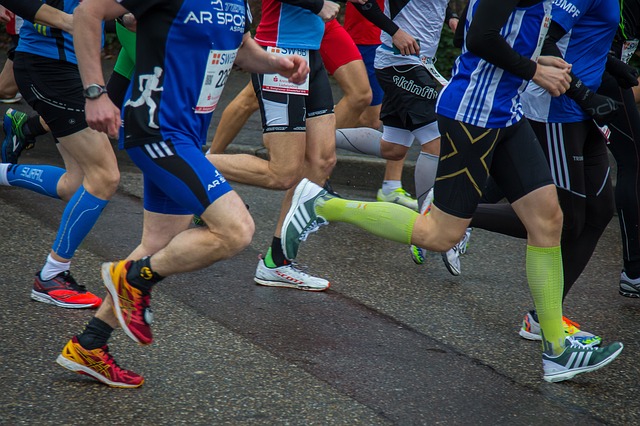The half marathon is one of the fastest growing races in the world – and for good reason. Half marathon training is approachable – and so is the race.
A post shared by Jason Fitzgerald (@jasonfitz1) on
Cheering finishers at the 2017 Colfax Half Marathon
At 13.1 miles, it’s long enough to require endurance and mental toughness, but short enough for most runners to tackle with less than a year of running experience.
Unlike a marathon, where the body is limited by the amount of carbohydrate (fuel) it can store, the half marathon allows most runners to finish strong. You likely won’t “hit the wall.”
Nevertheless, it will still take hard work. You can’t “fake” your way through half marathon training or the race itself like you can a 5k race.
But with the right training approach that prioritizes the elements of fitness that are specific to the HM distance, you’ll experience tremendous progress and hopefully, a faster finish time.
There are three fundamental types of workouts that are critical for success in the half marathon.
Let’s begin with the most general – the long run.
Half Marathon Workout #1: The Long Run

When half marathon training pays off…
Every runner must run a weekly long run – no matter what distance you’re training to complete.
They build general endurance so you can:
- run further
- complete longer and more intense workouts
- maintain faster paces for longer periods of time
In other words, long runs build your capacity for work. They increase your ability to tolerate a high workload.
Or, as Bill Squires said:
The Long Run puts the tiger in the cat!
Beginners should particularly focus on long runs because their lack of endurance is the top obstacle to faster racing.
Long runs increase running economy (efficiency) so that you can run faster with less effort. It’s like increasing your car’s fuel economy – you can go further on the same amount of fuel.
They also make the half marathon distance comfortable – so you can then worry about running it fast rather than just completing the distance.
During a 12-20 week training period, add a mile to your long run every 1-2 weeks but take a “recovery week” every 4-6 weeks where the long run distance dips by 2-3 miles. Run at least 10-11 miles during training to ensure you can complete the half marathon comfortably.
More advanced runners will want to run significantly more than 13.1 miles during their peak long run – even up to 20 miles. This video about half marathon long runs can help you think more strategically about planning your long runs:
The longer you can safely run, the more you can focus on speed on race day.
If you want more guidance on building your long run and mileage, this article shows you how (it’s NOT the 10% rule…).
Half Marathon Workout #2: The Tempo Run
Tempo runs are what I consider “bread and butter” workouts for any runner training for the 10k – 50 kilometers. They’re that useful!
This is because they help push your endurance to new levels. More specifically, they increase your body’s ability to clear lactate from your blood stream, which is a byproduct of hard exercise.
Tempo runs help you run at a faster pace without accumulating excessive lactate, ultimately helping you maintain a faster pace for a longer period of time.
There are quite a few definitions of “Tempo:”
- The pace that you can hold for about an hour (often correlating with 10k Pace for some runners)
- A “comfortably hard” pace (for those who like to run by perceived effort)
- The pace that causes your heart rate to reach 85-90% of maximum (if you prefer heart rate monitor training)
Beginners can start with tempo intervals which are simply 2-5 minutes at tempo pace with 1-2 minutes of easy running as recovery. Aim to complete roughly 15-20 minutes at tempo pace.
Advanced runners can skip the recovery running and instead run 3-5 miles at tempo pace with no rest.
And of course, you’ll want to run a few easy miles before and after any tempo workout to ensure you have a proper warm-up and cool-down.
Half Marathon Workout #3: HM-Specificity
Specificity is the golden rule in running: training must be specific to the goal race.
These workouts are slightly more advanced, so if you’re a beginner, you can just run easy mileage, long runs, and tempo workouts.
But advanced runners need an extra challenge for a new personal best. Half marathon-specific workouts closely resemble the race. At its most basic, you’ll run at half marathon pace for 6-8 miles.
Here are two more examples:
- Two repetitions of 5km at goal half marathon pace, with 2 minutes of easy running as recovery.
- End a long run of 13-18 miles with 3-6 miles at goal half marathon pace (this workout makes you run fast in a fatigued condition, making it even more specific to the half).
Workouts like these should be done in the final 4-6 weeks before the goal race so you don’t get too fatigued or burned out too early in the season.
Most beginners will see rapid improvement without these challenging sessions. If you’re not ready for workouts like this yet, that’s ok! You can simply skip them.
These workouts help you build a foundation of endurance so that your next 13.1 miles can be your best. Focus, prepare intelligently, and run strong!
If you’d like help with your half marathon training, we have many coaching programs to help you snag your next personal best.
Or, use our Season Planner worksheet to plan a more strategically structured season!
A version of this article initially appeared on Competitor.com.